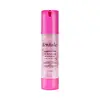What's inside
What's inside
 Key Ingredients
Key Ingredients

 Benefits
Benefits

 Concerns
Concerns

 Ingredients Side-by-side
Ingredients Side-by-side

Water
Skin ConditioningGlycerin
HumectantDimethicone
EmollientPropanediol
SolventNiacinamide
SmoothingGlyceryl Glucoside
HumectantPropylene Glycol
HumectantDicaprylyl Carbonate
EmollientCentella Asiatica Extract
CleansingBetaine
HumectantPhenoxyethanol
PreservativeCapryloyl Glycine
CleansingAzelaic Acid
BufferingAllantoin
Skin ConditioningCyclopentasiloxane
EmollientAmmonium Acryloyldimethyltaurate/Vp Copolymer
Carbomer
Emulsion StabilisingEthylhexylglycerin
Skin ConditioningCalcium Alginate
MaskingXanthan Gum
EmulsifyingAgar
MaskingMica
Cosmetic Colorant1,2-Hexanediol
Skin ConditioningHydroxyacetophenone
AntioxidantSodium Hydroxide
BufferingDisodium EDTA
Parfum
MaskingCI 77891
Cosmetic ColorantCI 12490
Cosmetic ColorantCI 74160
Cosmetic ColorantWater, Glycerin, Dimethicone, Propanediol, Niacinamide, Glyceryl Glucoside, Propylene Glycol, Dicaprylyl Carbonate, Centella Asiatica Extract, Betaine, Phenoxyethanol, Capryloyl Glycine, Azelaic Acid, Allantoin, Cyclopentasiloxane, Ammonium Acryloyldimethyltaurate/Vp Copolymer, Carbomer, Ethylhexylglycerin, Calcium Alginate, Xanthan Gum, Agar, Mica, 1,2-Hexanediol, Hydroxyacetophenone, Sodium Hydroxide, Disodium EDTA, Parfum, CI 77891, CI 12490, CI 74160
Water
Skin ConditioningCaprylic/Capric Triglyceride
MaskingMyristyl Myristate
EmollientEthylhexyl Stearate
EmollientCetearyl Alcohol
EmollientPropanediol
SolventCetearyl Ethylhexanoate
EmollientC14-22 Alcohols
Emulsion StabilisingMangifera Indica Seed Butter
Skin ConditioningArachidyl Alcohol
EmollientC12-20 Alkyl Glucoside
EmulsifyingBehenyl Alcohol
EmollientOctyldodecanol
EmollientSqualane
EmollientArachidyl Glucoside
EmulsifyingDimethicone
EmollientSaccharide Isomerate
HumectantPanthenol
Skin ConditioningTocopheryl Acetate
AntioxidantCeramide AP
Skin ConditioningSodium Hyaluronate
HumectantSodium Hyaluronate Crosspolymer
HumectantBorago Officinalis Seed Oil
EmollientSimmondsia Chinensis Seed Oil
EmollientPhenoxyethanol
PreservativeAllantoin
Skin ConditioningPotassium Cetyl Phosphate
EmulsifyingCarbomer
Emulsion StabilisingTriethanolamine
BufferingEthylhexylglycerin
Skin ConditioningParfum
MaskingWater, Caprylic/Capric Triglyceride, Myristyl Myristate, Ethylhexyl Stearate, Cetearyl Alcohol, Propanediol, Cetearyl Ethylhexanoate, C14-22 Alcohols, Mangifera Indica Seed Butter, Arachidyl Alcohol, C12-20 Alkyl Glucoside, Behenyl Alcohol, Octyldodecanol, Squalane, Arachidyl Glucoside, Dimethicone, Saccharide Isomerate, Panthenol, Tocopheryl Acetate, Ceramide AP, Sodium Hyaluronate, Sodium Hyaluronate Crosspolymer, Borago Officinalis Seed Oil, Simmondsia Chinensis Seed Oil, Phenoxyethanol, Allantoin, Potassium Cetyl Phosphate, Carbomer, Triethanolamine, Ethylhexylglycerin, Parfum
Ingredients Explained
These ingredients are found in both products.
Ingredients higher up in an ingredient list are typically present in a larger amount.
Allantoin is a soothing ingredient known for its protective and moisturizingg properties. Because of this, it is often added to products with strong active ingredients.
Studies show higher concentrations of this ingredient can promote wound healing.
Though it can be derived from the comfrey plant, allantoin is produced synthetically for cosmetic products to ensure purity.
Learn more about AllantoinCarbomer is a polymer of acrylic acid. Its main role is to create a gel consistency.
A high amount of carbomer can cause pilling or balling up of products. Don't worry, most products contain 1% or less of carbomer.
Dimethicone is a type of synthetic silicone created from natural materials such as quartz.
What it does:
Dimethicone comes in different viscosities:
Depending on the viscosity, dimethicone has different properties.
Ingredients lists don't always show which type is used, so we recommend reaching out to the brand if you have questions about the viscosity.
This ingredient is unlikely to cause irritation because it does not get absorbed into skin. However, people with silicone allergies should be careful about using this ingredient.
Note: Dimethicone may contribute to pilling. This is because it is not oil or water soluble, so pilling may occur when layered with products. When mixed with heavy oils in a formula, the outcome is also quite greasy.
Learn more about DimethiconeEthylhexylglycerin (we can't pronounce this either) is commonly used as a preservative and skin softener. It is derived from glyceryl.
You might see Ethylhexylglycerin often paired with other preservatives such as phenoxyethanol. Ethylhexylglycerin has been found to increase the effectiveness of these other preservatives.
Parfum is a catch-all term for an ingredient or more that is used to give a scent to products.
Also called "fragrance", this ingredient can be a blend of hundreds of chemicals or plant oils. This means every product with "fragrance" or "parfum" in the ingredients list is a different mixture.
For instance, Habanolide is a proprietary trade name for a specific aroma chemical. When used as a fragrance ingredient in cosmetics, most aroma chemicals fall under the broad labeling category of “FRAGRANCE” or “PARFUM” according to EU and US regulations.
The term 'parfum' or 'fragrance' is not regulated in many countries. In many cases, it is up to the brand to define this term.
For instance, many brands choose to label themselves as "fragrance-free" because they are not using synthetic fragrances. However, their products may still contain ingredients such as essential oils that are considered a fragrance by INCI standards.
One example is Calendula flower extract. Calendula is an essential oil that still imparts a scent or 'fragrance'.
Depending on the blend, the ingredients in the mixture can cause allergies and sensitivities on the skin. Some ingredients that are known EU allergens include linalool and citronellol.
Parfum can also be used to mask or cover an unpleasant scent.
The bottom line is: not all fragrances/parfum/ingredients are created equally. If you are worried about fragrances, we recommend taking a closer look at an ingredient. And of course, we always recommend speaking with a professional.
Learn more about ParfumPhenoxyethanol is a preservative that has germicide, antimicrobial, and aromatic properties. Studies show that phenoxyethanol can prevent microbial growth. By itself, it has a scent that is similar to that of a rose.
It's often used in formulations along with Caprylyl Glycol to preserve the shelf life of products.
Propanediol is an all-star ingredient. It softens, hydrates, and smooths the skin.
It’s often used to:
Propanediol is not likely to cause sensitivity and considered safe to use. It is derived from corn or petroleum with a clear color and no scent.
Learn more about PropanediolWater. It's the most common cosmetic ingredient of all. You'll usually see it at the top of ingredient lists, meaning that it makes up the largest part of the product.
So why is it so popular? Water most often acts as a solvent - this means that it helps dissolve other ingredients into the formulation.
You'll also recognize water as that liquid we all need to stay alive. If you see this, drink a glass of water. Stay hydrated!
Learn more about Water